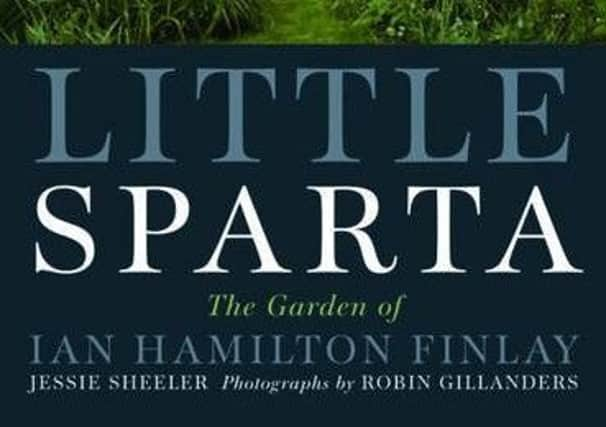Book reviews: The New Concrete | Little Sparta


The New Concrete: Visual Poetry in the 20th Century
Eds Victoria Bean and Chris McCabE
Hayward Pubilshing, 240pp, £30
Little Sparta: A Guide to The Garden of Ian Hamilton Finlay
Jessie Sheeler
Birlinn, 196pp, £14.99
If the greatness of an artist can be measured by the extent to which their influence persists after they die, then Ian Hamilton Finlay deserves all the plaudits going. One of the key movers in the concrete poetry movement as it ebbed and flowed through the second half of the 20th century, his work is referenced so many times in Victoria Bean and Chris McCabe’s comprehensive survey of the current scene that it’s almost as if he has become a sort of guiding spirit, invoked both explicitly and implicitly by many of those currently working in the field.
In an excellent introduction – notable for its clarity, at a time when many art books still seem to be written in almost comically impenetrable theory-speak – the poet Kenneth Goldsmith describes how concrete or visual poetry blossomed in the 1950s and 60s, fell out of fashion in the late 1970s and how, more recently, it has re-emerged as “a digital phoenix”, given a new lease of life by the endless possibilities of the internet and advanced design software.
Advertisement
Hide Ad“Concrete poems being written in the twenty-first century have all been strained through the digital,” he writes, but he also notes that “concrete poetry in the twenty-first century always winks at its twentieth-century precursors.”
Chief among those being winked at here is Finlay. In ‘A Small Tree’ of 2012, Tony Lopez pays tribute to the one-word poem, a form Finlay devised, in which the title can contain an unlimited number of words but the poem itself only one. In conjunction with a photograph by John S Webb, Lopez riffs on the multiple meanings tied up in the word Hawthorn, including (but not limited to) the name of the anti-war campaigner Brian Haw and Finlay’s own Wild Hawthorn Press. Elsewhere, in ‘The Day Ian Hamilton Finlay Died’ Antonio Claudio Carvalho meditates on the word “Sad” in a series of stark, colourful prints, while Aram Saroyan’s twin poems ‘ian hamilton finlay’ and ‘wwww’ unfold their meaning slowly, delicately, and in a way in which the man who inspired them would surely have approved.
Ironically, one of the criticisms levelled at the clean, understated style deployed by Finlay and others in the revolutionary late 1960s was that it somehow failed to engage adequately with the real world. As the media archaeologist Lori Emerson puts it: “such cleanliness was thought to indicate a lack of political engagement.” The French poet Henri Chopin advocated scruffy-looking “dirty concrete” as an alternative. Fast-forward to the present day, and we find a new generation of Turkish artists, as Victoria Bean puts it, using the medium of concrete poetry “to say the unsayable.” On the evidence here, however, Ercan y Yilmaz and Baris Cetinkol both owe more to Finlay’s aesthetic than to Chopin’s.
Of course, anyone doubting Hamilton Finlay’s political engagement need only take a trip to his masterpiece, Little Sparta, situated in the Pentland Hills to the south-west of Edinburgh. To the casual observer, this garden-as-gesamtkunstwerk may simply look like an agreeable place for a stroll, but every sculpture, signpost and watering can is layered with meaning, all of it linked, however obliquely, to a very particular world view. Indeed, the garden as a whole can be read as a political statement: the first thing visitors see as they arrive is The Monument to the First Battle of Little Sparta, which recalls how, in 1983, Finlay’s supporters successfully prevented the removal of works from the garden’s temple by Strathclyde Regional Council in a dispute over rates – a triumph of art over bureaucracy.
Jessie Sheeler’s new guidebook, illustrated with Robin Gillanders’ atmospheric photographs, does a lucid and erudite job of breaking all this down; an essential companion for anyone planning to visit one of Scotland’s greatest art treasures.